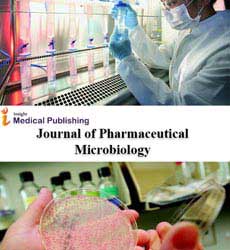New Generation Disinfectants
Mujde Eryilmaz
| Mujde Eryilmaz* Faculty of Pharmacy, Department of Pharmaceutical Microbiology, Ankara University, Turkey |
| Corresponding Author: Mujde Eryilmaz, Faculty of Pharmacy, Department of Pharmaceutical Microbiology, Ankara University, Turkey E-mail: Mujde.Eryilmaz@ankara.edu.tr |
| Received: February 04, 2016; Accepted: February 08, 2016; Published: February 15, 2016 |
| Citation: Eryilmaz M. New Generation Disinfectants. J Pharm Microbiol. 2016, 2:1. |
Abstract
Determining the appropriate disinfectant and proper applications of it are so important for controlling the spread of infections and protecting the public’s health. Disinfectants are chemical agents that are applied to non-living objects or surfaces to destroy microorganisms. These antimicrobial agents are extensively used in hospitals and other health care settings to control the spread of infectious diseases. They play an important role for the prevention of nosocomial infections. Furthermore, they are used in many industrial areas such as food and pharmaceutical industry. A wide range of chemical agents like alcohols, chlorine compounds, gluteraldehyde, iodophors, phenolics has been used for this aim for long years. Although most of them demonstrate broad-spectrum antimicrobial activity at higher concentrations, they have serious side effects on living organisms and also can cause environmental problems at these concentrations. On account of these reasons, safer and better compounds are urgently needed. Researchers try to improve new substances with lack of these disadvantages.
Keywords |
| Disinfectants, Environmental Protection Agency, antimicrobial activity |
New Generation Disinfectants |
| In recent years, both chlorine dioxide and hydrogen peroxide have gained important role for disinfection procedures. Both of them are powerful oxidative agents and they remove electrons from susceptible chemical groups. They inactivate microorganisms by attacking their cell walls and cytoplasmic membranes, denaturing proteins, preventing the transport of nutrients across the cell wall and inhibiting protein synthesis. |
| Chlorine dioxide is a yellow to reddish-yellow gas that can readily soluble in water. It has a broad spectrum antimicrobial activity against various types of microorganisms. Its bactericidal activity remains constant over a broader pH range from pH 3 to 8. In water, chlorine dioxide reacts rapidly to form chlorite ions. It is also a highly volatile compound that can easily remove from dilute aqueous solutions. During storing and reuse processes, it may lose its potency. In addition, chlorine dioxide gradually dissociates into chlorine and oxygen. Therefore, it must be stored in small containers or single use bottles [4]. |
| In the United States, usage of chlorine dioxide is limited at a maximum level of 0.8 mg/L as a drinking water disinfectant by Environmental Protection Agency. In Europe, it can be used in continuous disinfection processes in sanitary water supplies at 1.0 mg/L concentration. When chlorine dioxide concentration comes 10% or more in air, chlorine dioxide becomes explosive. Acute exposure of the skin at higher concentrations can lead serious damages such as irritations and burns. As understood from all this, it is a respiratory irritant compound and it may lead to irritation of eyes, nose throat and lungs. |
| Hydrogen peroxide has been used for various purposes as water disinfection and antiseptic for many years. Low eco toxicity, odorless and clear colorless is some of its advantages. It can be used in both liquid and gas forms for various purposes such as preservative, disinfectant and also for sterilization applications. It has a broad spectrum antimicrobial activity and it can be define safer material in comparison to other chemical agents that are used for same purpose. Decomposition products of hydrogen peroxide are water and oxygen. Effective and safer usage of hydrogen peroxide depends on area of usage and usage concentration. In addition of these, it is a strong oxidizing agent and can easily damage cellular macromolecules, including proteins, lipids and nucleic acids. Besides that, hydrogen peroxide is corrosive in case of eyes and skin contact and its vapor is irritating to the respiratory tract. |
| Hydrogen peroxide may be converted by neutrophils and macrophages to more reactive compounds such as superoxide and hydroxyl radicals. These reactive oxygen species have been suspected to adversely affect wound healing by causing cell membrane and DNA damage. For that reason, some studies indicated that hydrogen peroxide may be more cytotoxic than bactericidal. These are various commercial formulations available in markets containing additional ingredients such as silver, ethanol and acids. These substances increase the efficacy of hydrogen peroxide based formulations [5,6]. |
Summary |
| Chlorine dioxide and hydrogen peroxide are powerful oxidizing agents. They remove electrons from susceptible chemical groups and inactivate microorganisms by attacking their cell wall and cytoplasmic membrane, denaturing proteins, preventing the transport of nutrients across the cell wall and inhibiting protein synthesis. Their degradation products are safe for environment but they may lead to serious problems in case of inhalation contact with eyes and skin at higher concentrations. |
References |
|
Open Access Journals
- Aquaculture & Veterinary Science
- Chemistry & Chemical Sciences
- Clinical Sciences
- Engineering
- General Science
- Genetics & Molecular Biology
- Health Care & Nursing
- Immunology & Microbiology
- Materials Science
- Mathematics & Physics
- Medical Sciences
- Neurology & Psychiatry
- Oncology & Cancer Science
- Pharmaceutical Sciences
